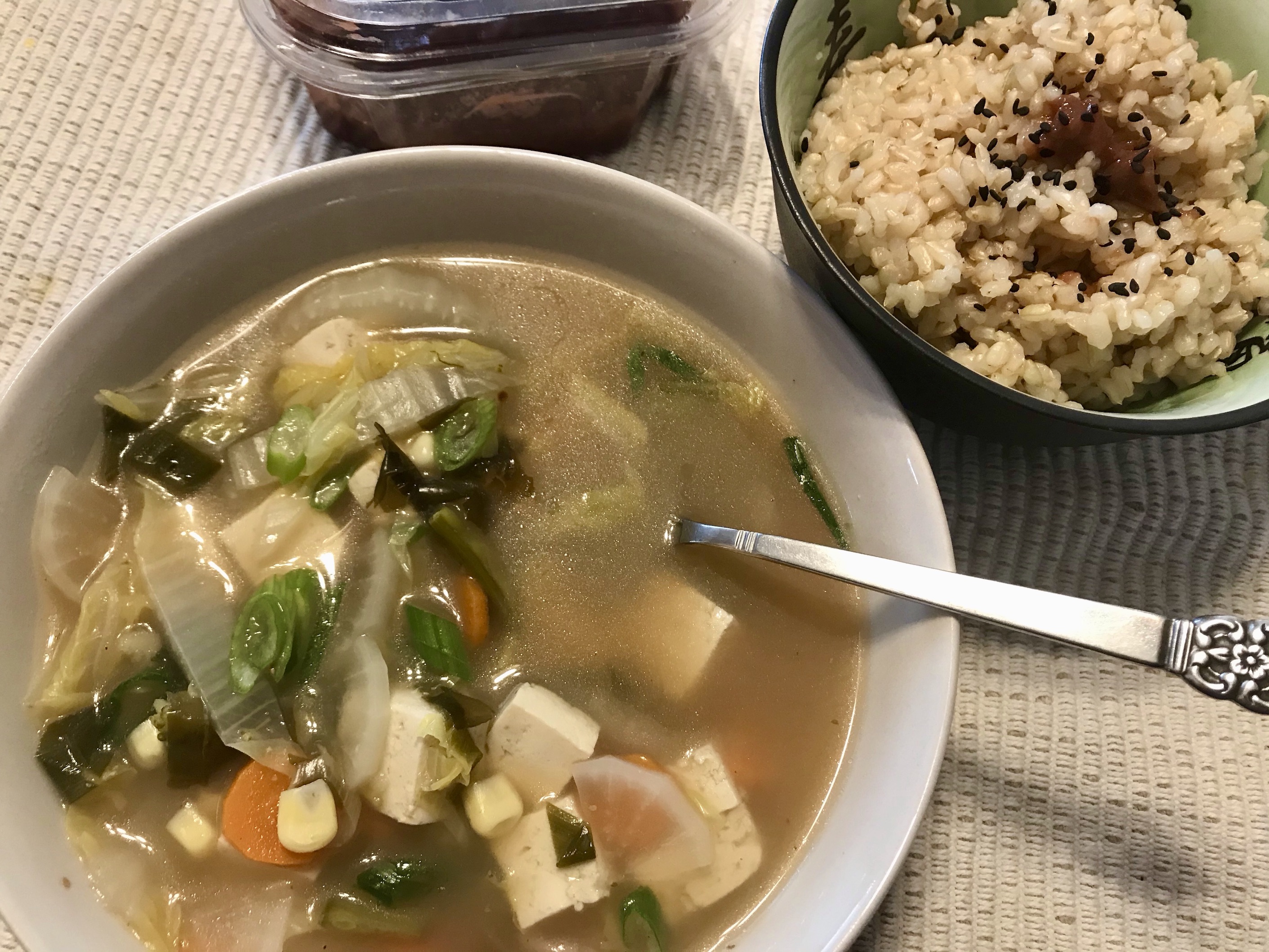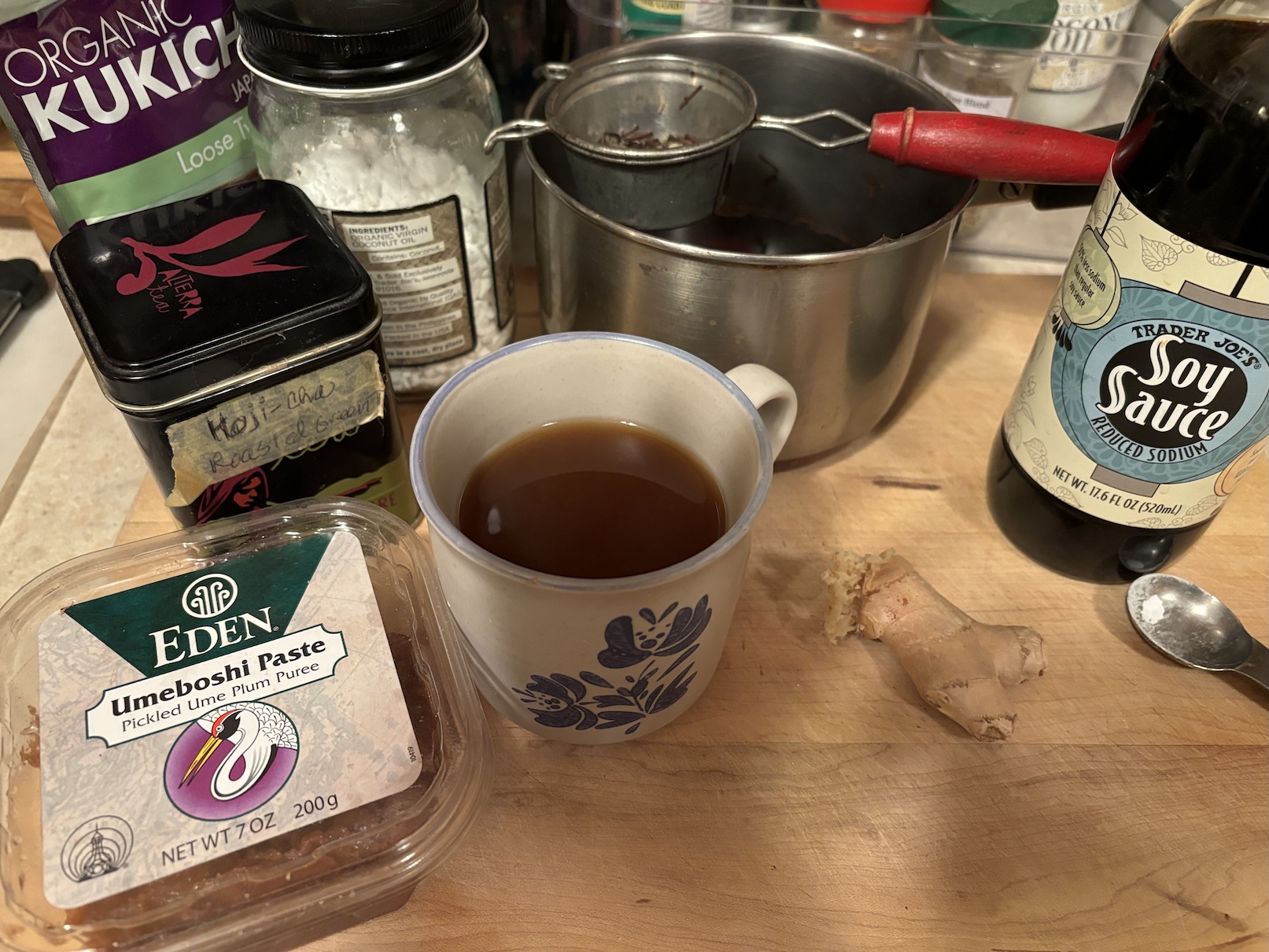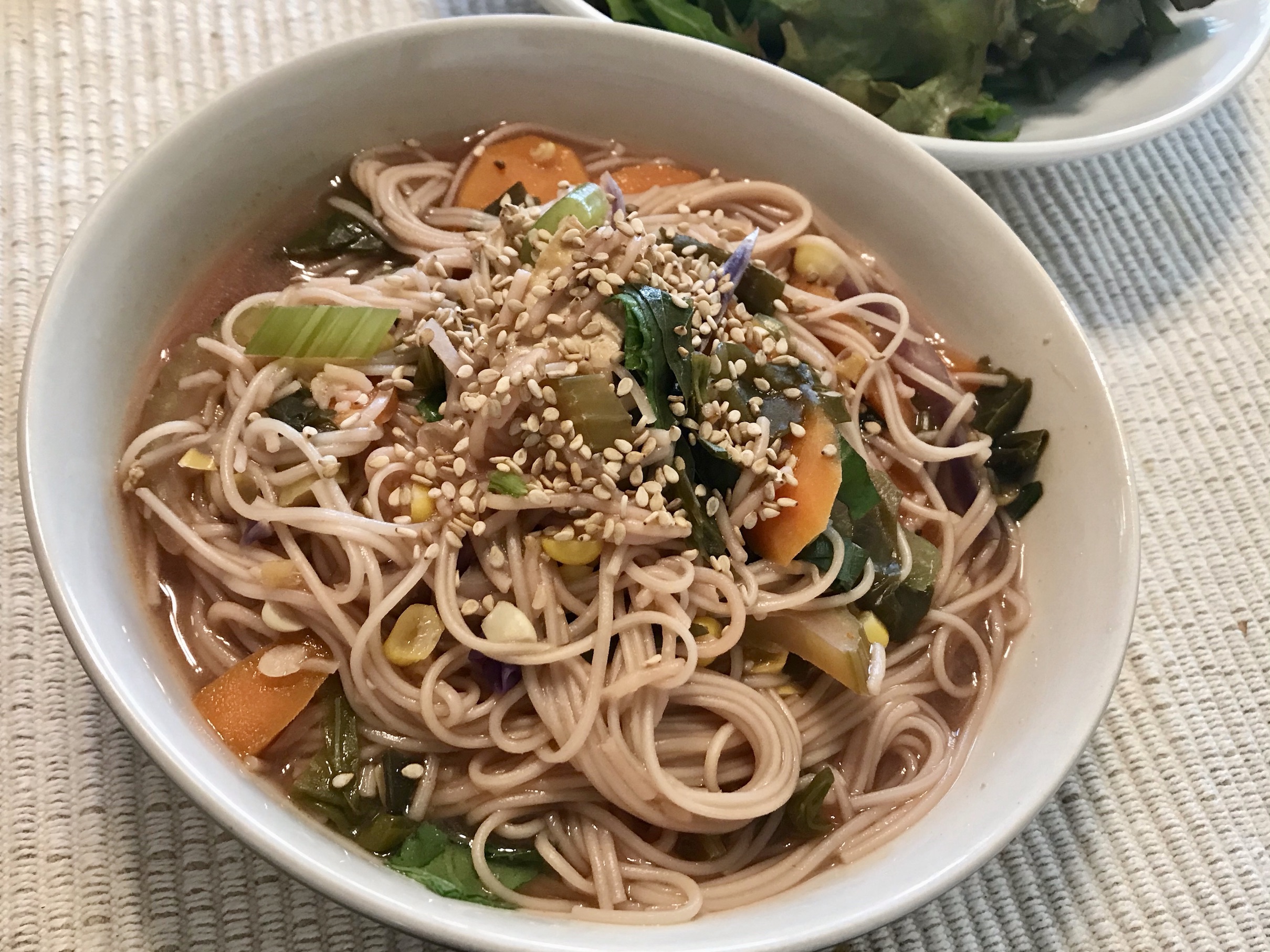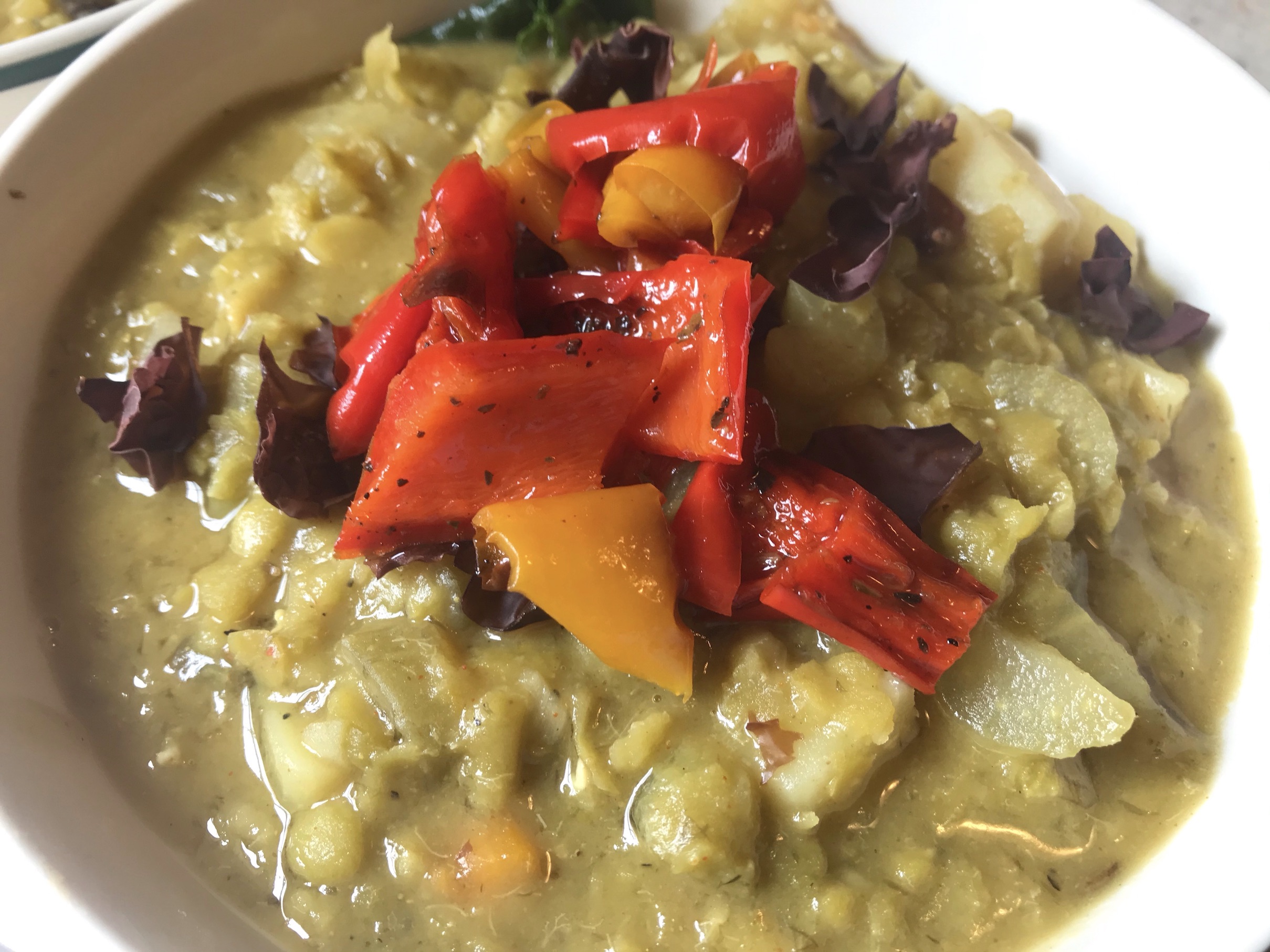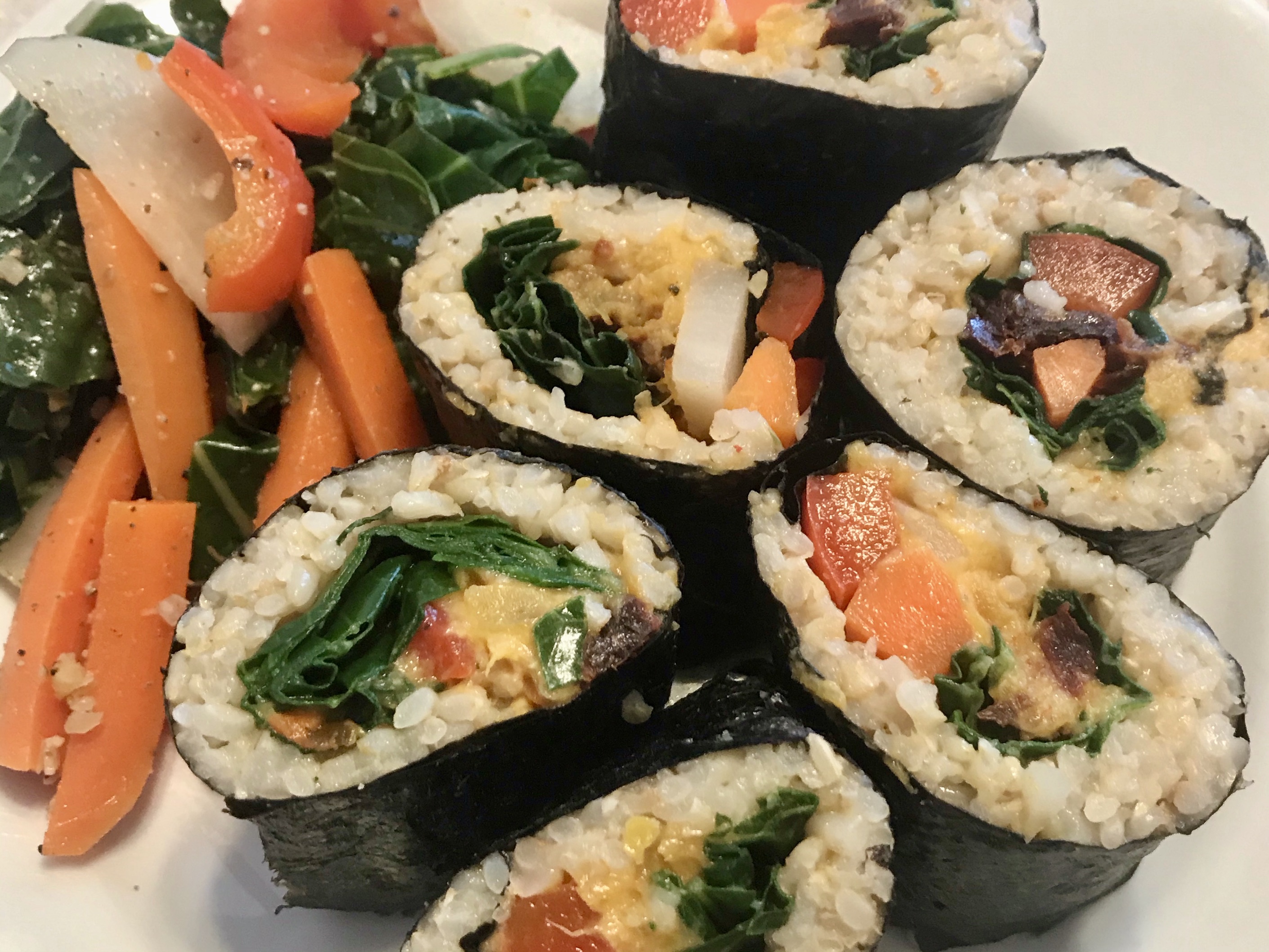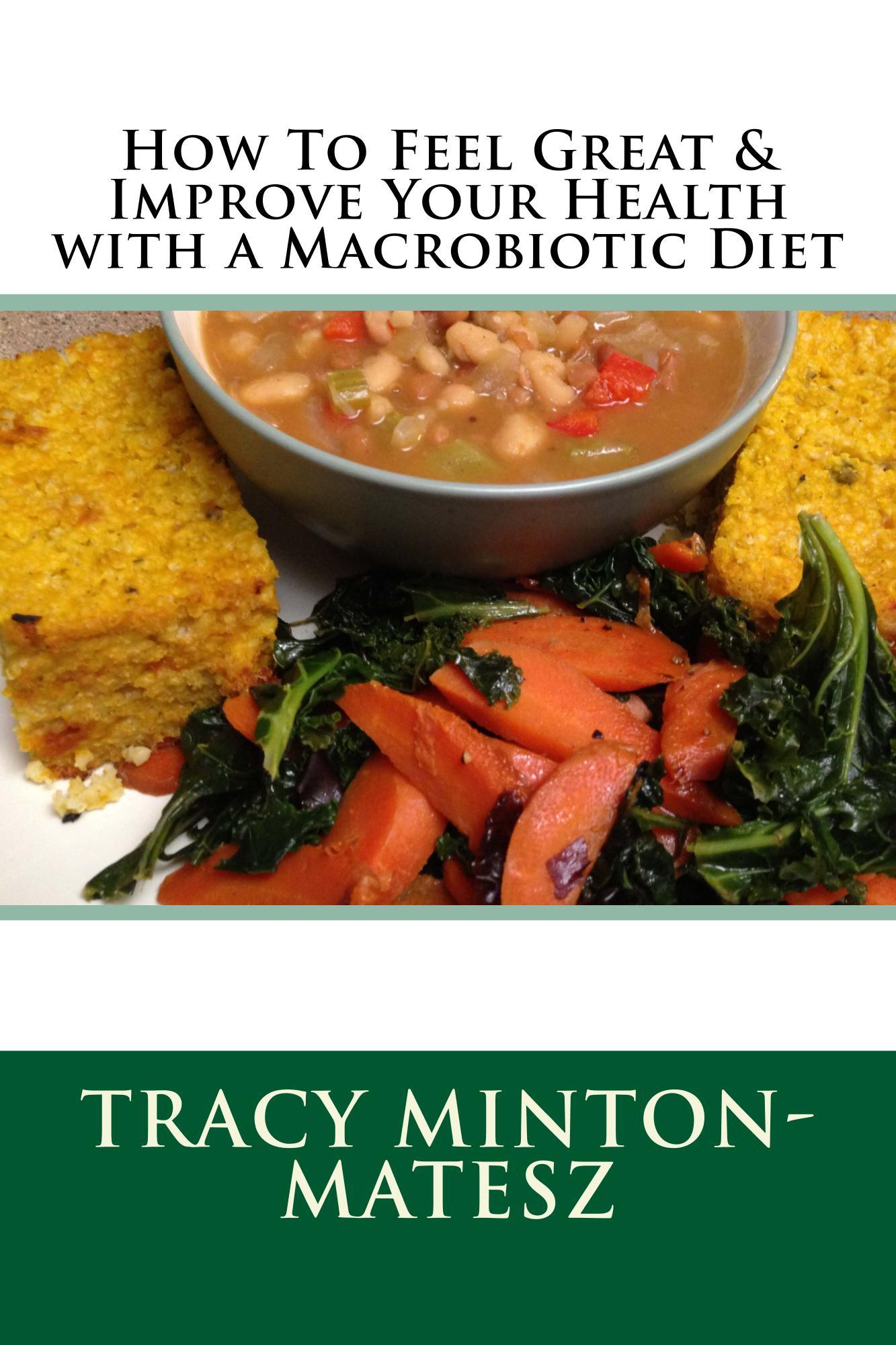Healthy Condiments For Macrobiotic Cooking, Savory Flavors with Benefits
Condiments for macrobiotic cooking provide savory flavors, without all the unwanted junk. They complement your meals, supplement your health, and are worthy of adorning your dinner table!
Hold the Heinz 57. Umeboshi plums (or paste), and Gomashio may sound weird, but they both have unique and amazing flavors that perfectly complement whole grains and vegetables. Plus, you won't find sodium benzoate, a preservative classified as GRAS, 'generally regarded as safe' (whatever that means), high fructose corn syrup, caramel color or unknown 'natural flavors' in these condiments like you will find in Heinz 57, a tangy sauce designed to perk up the flavor of otherwise bland meat.
Condiments for macrobiotic cooking ~ including the two mentioned above, along with seaweeds and others ~ complement the flavors of whole, fresh plant foods, and provide needed sodium in an easy to digest and assimilate manner.
- Home
- Meal Prep / Batch Cooking Tips
- Best Brown Rice, Rice Balls, Sushi & Porridge
- Condiments for Macrobiotic Cooking
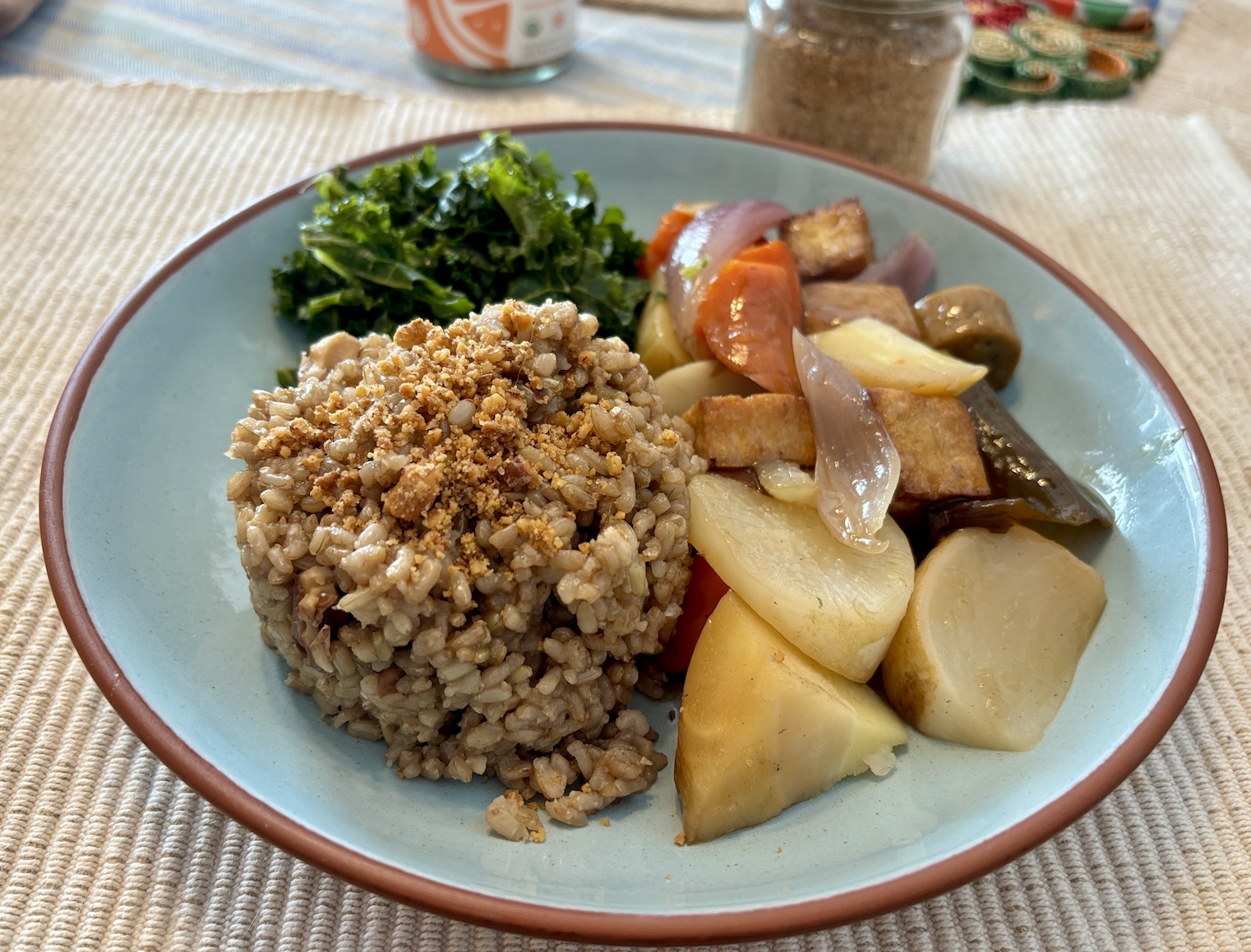
Healthy Savory Condiments for Macrobiotic Cooking
The right condiments help the natural flavors of fresh plant foods come alive.
Seasonings and condiments for macrobiotic cooking are adjusted seasonally and as needed individually, depending on one's condition, all of which contribute to the overall enjoyment and balance of a meal, and its effectiveness at improving health.
In this article, I highlight three important condiments for macrobiotic cooking that can be used and modified in a variety of ways: Gomasio, Seaweeds, and Umeboshi Plum or Paste.
Salty condiments used for macrobiotic cooking, such as umeboshi plums and Gomashio help preserve food naturally, (think Brown Rice Balls with Umeboshi Plum to-go), and balance the higher potassium content of plant foods relative to sodium. By contrast, animal foods are much higher in sodium than potassium.
According to Sagen Ishizuka, an early pioneer of macrobiotics which I wrote about in The Macrobiotic Action Plan, Your MAP to Greater Health & Happiness, getting the right balance of sodium to potassium (Na:K) salts is important for health. In macrobiotic terms, salty, mineral-rich foods are more alkaline, and help us feel more yang, that is to say more grounded, balanced, confident, courageous, happy and healthy.
Excess potassium in the diet, especially in conjunction with a deficiency of sodium and excess of fluids ~ which unfortunately I was doing ~ can lead to many health imbalances, including feeling tired, dizziness, too low blood pressure, 'adrenal fatigue' symptoms, constipation, premature aging signs such as early greying and wrinkling, hair loss, skin problems, bone and dental deterioration, and possibly even certain cancers ~ much of which I personally experienced from making this easy-to-remedy-yet problematic dietary mistake!
I'll discuss this in greater detail in a separate article. Just need to emphasize: these salty condiments used for macrobiotic cooking are a highly beneficial addition to your diet!
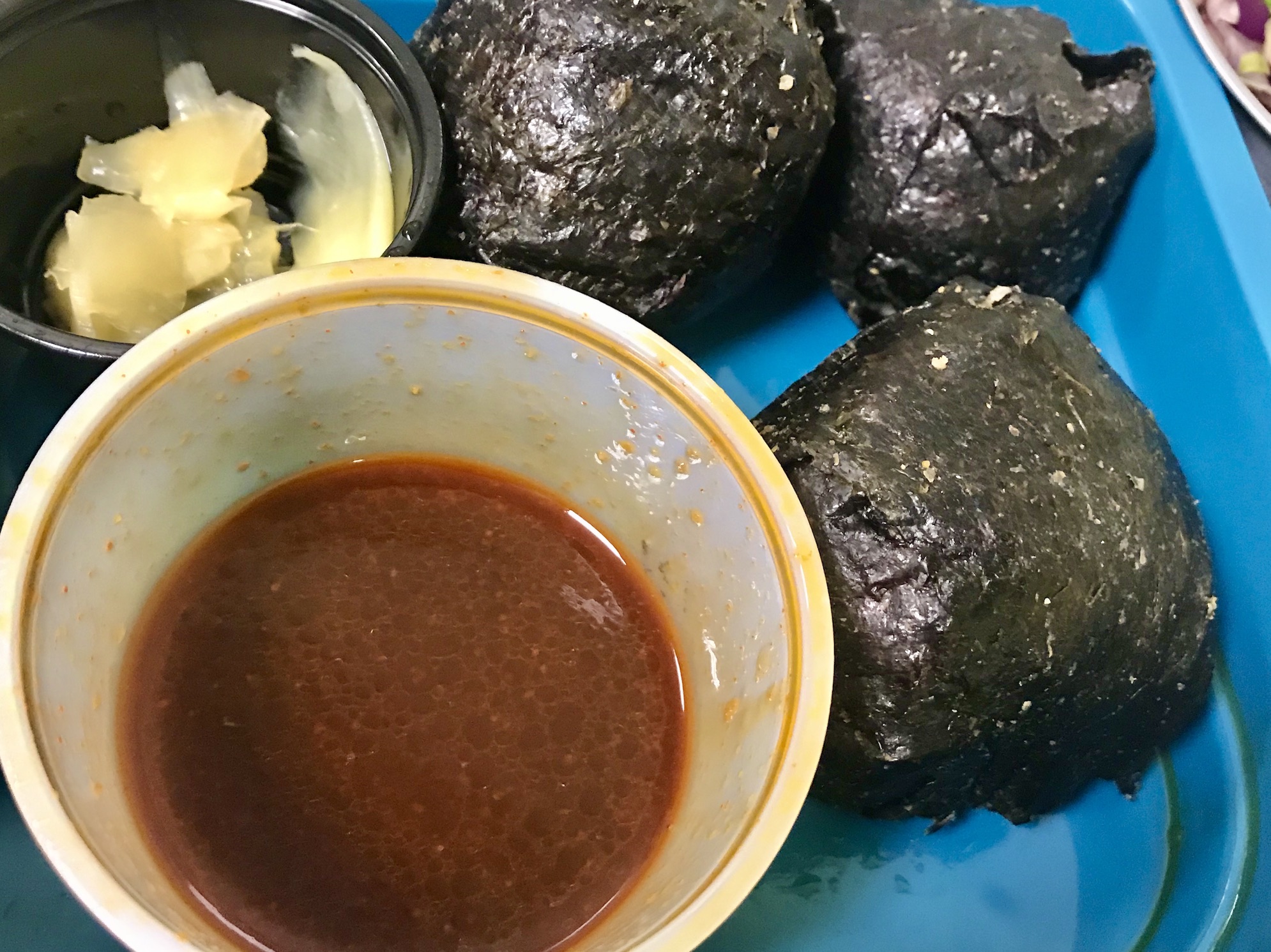
Kelp or kombu seaweed also supply iodine, another important element required for proper functioning of the thyroid, which regulates appetite, body temperature, weight, and much more. Additionally, kelp or kombu cooked with (pre-soaked) dried beans, makes them more tender, easier to digest, and less gas-forming.
The three types of condiments used for macrobiotic cooking featured in the remainder of this article ~ umeboshi plums and paste, Gomashio and seaweed ~ enhance flavor and aid digestion of the principal foods - whole grains, vegetables, and beans.
First up: Gomashio, a much beloved condiment in macrobiotic cooking!
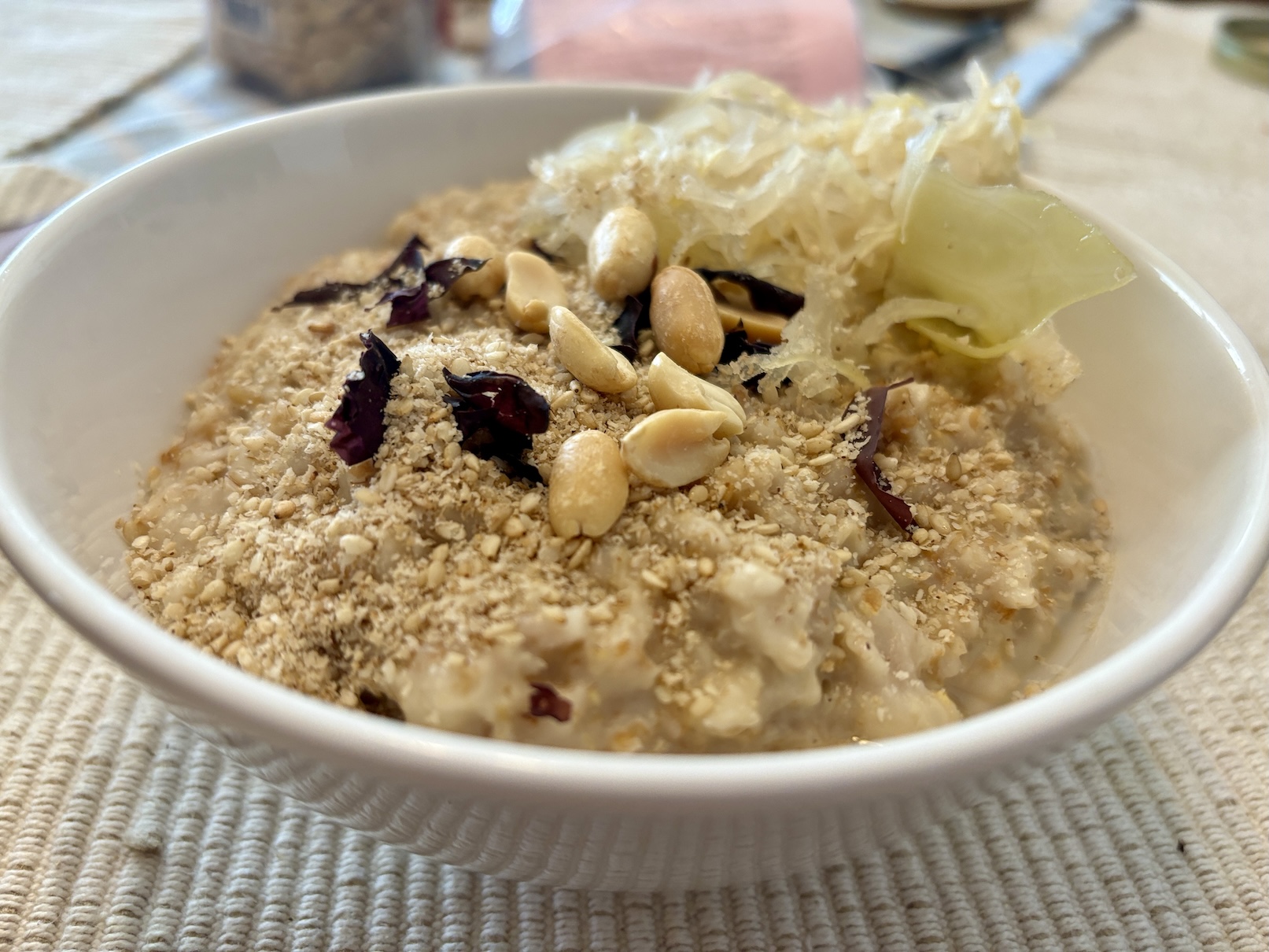 BF Oats (& optional barley, millet, or LO brown rice) is great topped with Gomashio, dulse, chopped dry roasted peanuts & sauerkraut
BF Oats (& optional barley, millet, or LO brown rice) is great topped with Gomashio, dulse, chopped dry roasted peanuts & sauerkraut
Gomashio, A Favorite Condiments for Macrobiotic Cooking!
Gomasio, or sesame-salt, is among the must-have condiments for macrobiotic cooking ~ especially great on top of brown rice. It is easy to make, providing you have a suribachi.
In The Art of Just Cooking, Lima Ohsawa (1899-2000) writes, "Gomashio is a very versatile condiment used in place of ordinary table salt." She goes on to explain how the oils in the sesame seeds (considered more Yin in macrobiotics) combined with the (more Yang) sea salt 'helps balance it in our body' and makes for a 'delicious harmony' that is perfect for grain and vegetable dishes.
Click here to learn more, and get the recipe for Gomashio Sesame Salt, Walnut Salt & Black Walnut Salt Variations.
Many who believe that 'brown rice is constipating' (myself included at one point!) may be surprised as to how much better they digest (well chewed) rice when properly prepared with enough salt, and salty condiments! (Here's my recipe for Perfect Brown Rice.)
Up next: Umeboshi Plums & Paste.
 Bowl of fresh pressure cooked brown rice topped with Gomashio Bowl of fresh pressure cooked brown rice topped with Gomashio |
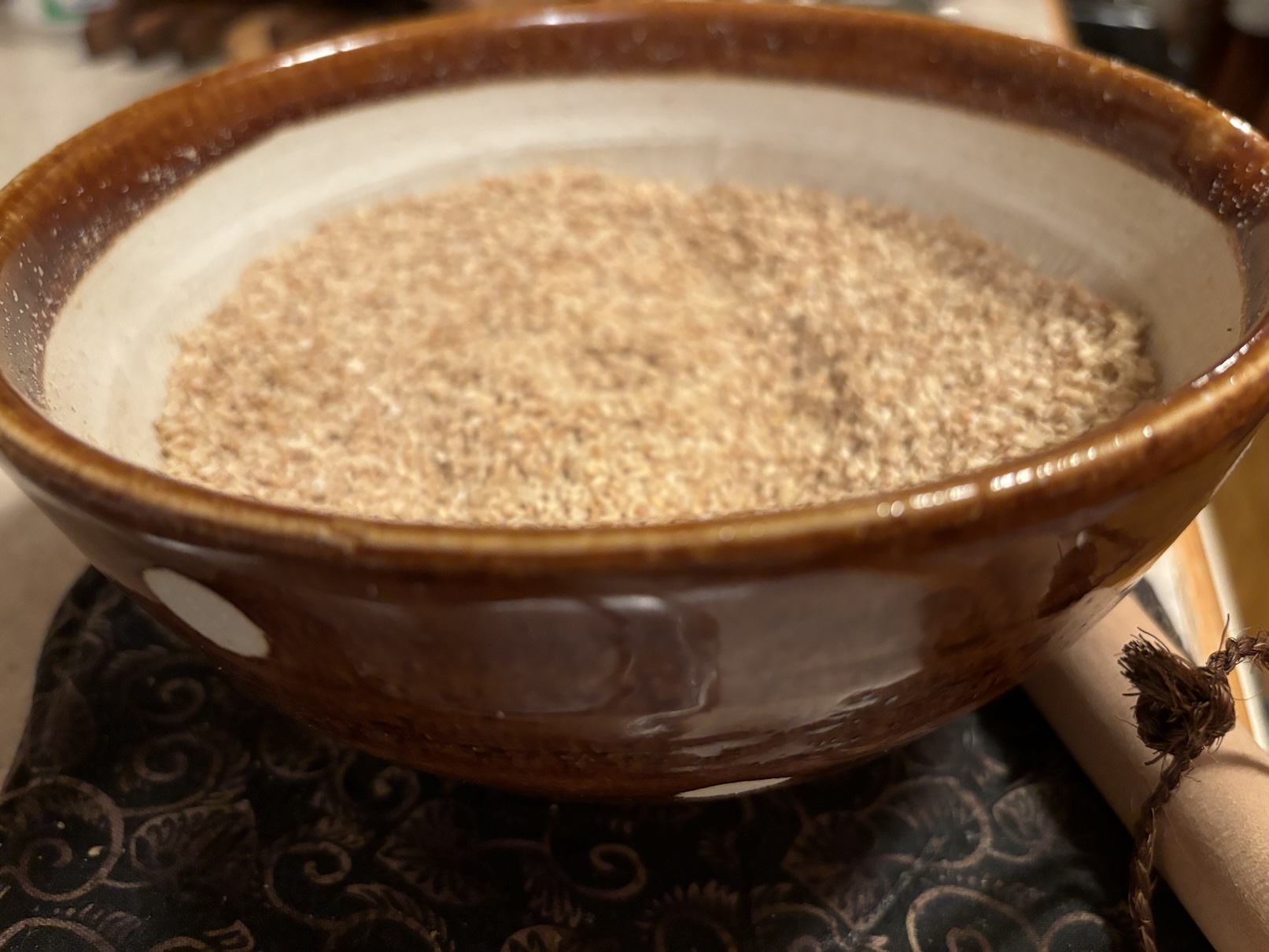 Roasted sesame seeds and sea salt in the suribachi to grind and make Gomashio Roasted sesame seeds and sea salt in the suribachi to grind and make Gomashio |
"It is in the preparation of simple foods like rice and gomashio that a cook's real skill is tried. It is far easier to assemble a rich gourmet feast than to produce consistently delicious, well-balanced sesame-salt. Mastery of this simple condiment means mastery of the center of your life." ~ The Art of Just Cooking, Lima Ohsawa
Umeboshi Plums, Paste or Vinegar - Great condiments for Brown Rice, Corn, Quick Pickles, in Healing Tea & More
Another of our favorite condiments for macrobiotic cooking, which can also be used in healing remedies is umeboshi plums, or pickled plums, typically made with shisho leaf added, which gives it a nice red color. They impart a salty sour flavor, are very alkalizing, and have so many uses, I may have to turn this into it's own page!
In Zen Macrobiotics (pocketbook ed., Ohsawa Foundation, Inc. 1965), George Ohsawa states that all traditional Japanese families prepare umeboshi plums every year. Good quality plums are aged 3 years.
Although good quality, appropriately fermented plums are excellent, we stay stocked up with Eden Foods Umeboshi Plum Paste, which is a bit easier to use.
The sour flavor is associated with the Liver / Gallbladder paired organ system, which is part of the Wood element in Chinese 5-Element Theory. Umeboshi plums (used in small amounts) is beneficial to the Liver (along with small amounts of other sour foods, and leafy greens.)
Eden Umeboshi Paste is soooo good on brown rice, in Brown Rice Balls (which doubles as a preservative so you can pack these babies to-go!), and spread on corn-on-the-cob. A little goes a long way! Start by using 1/4-1/3 tsp. ume paste stirred into a 1/2-1 cup serving of brown rice, or smeared on corn-on-the-cob to start, then add more to taste.
Whole umeboshi plums can be enjoyed 2-3 times per week as a condiment alongside a meal as you would any pickles which aid digestion.
As a word of caution, condiments used for macrobiotic cooking are enjoyed judiciously. They should enhance flavors, and balance Yin/Yang elements of a meal or dish, without creating further imbalances. Too much sour flavor can be injurious to the Liver / Gallbladder, Wood element.
Umeboshi plums, paste, or Eden Ume Plum Vinegar can also be used for making a vinaigrette for salads, pressed salads, or quick pickles. Drizzle ume vinegar on QB Greens & Vegetables (along with a little toasted sesame oil or high lignin flax oil), or try this Quick Napa Cabbage Pressed Salad / vegetable garnish.
Some foods prepared with the various condiments for macrobiotic cooking featured in this article
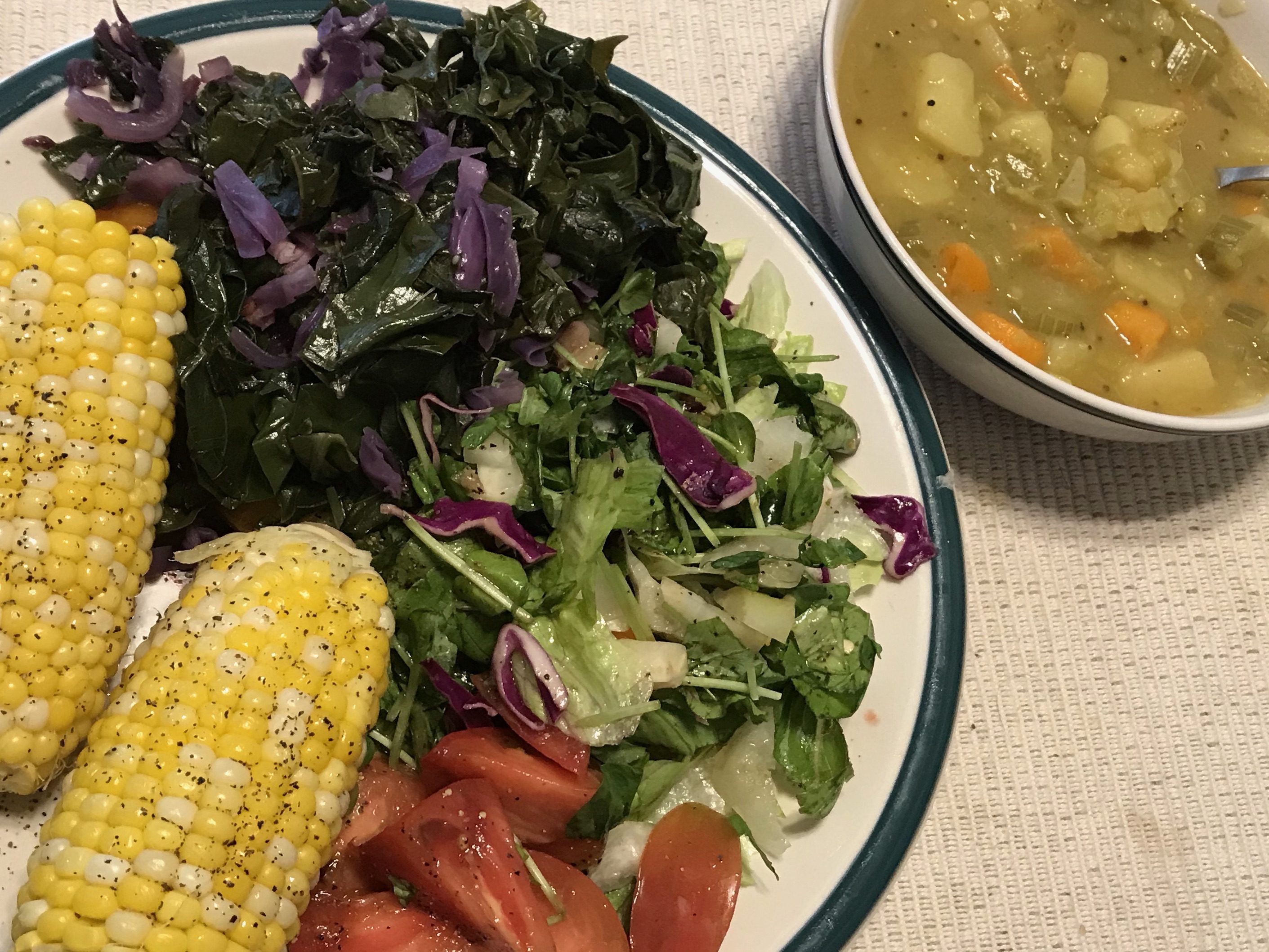 Corn-on-the-cob comes alive with a little bit of umeboshi plum paste spread on top ~ you'll never mis the butter!
Corn-on-the-cob comes alive with a little bit of umeboshi plum paste spread on top ~ you'll never mis the butter!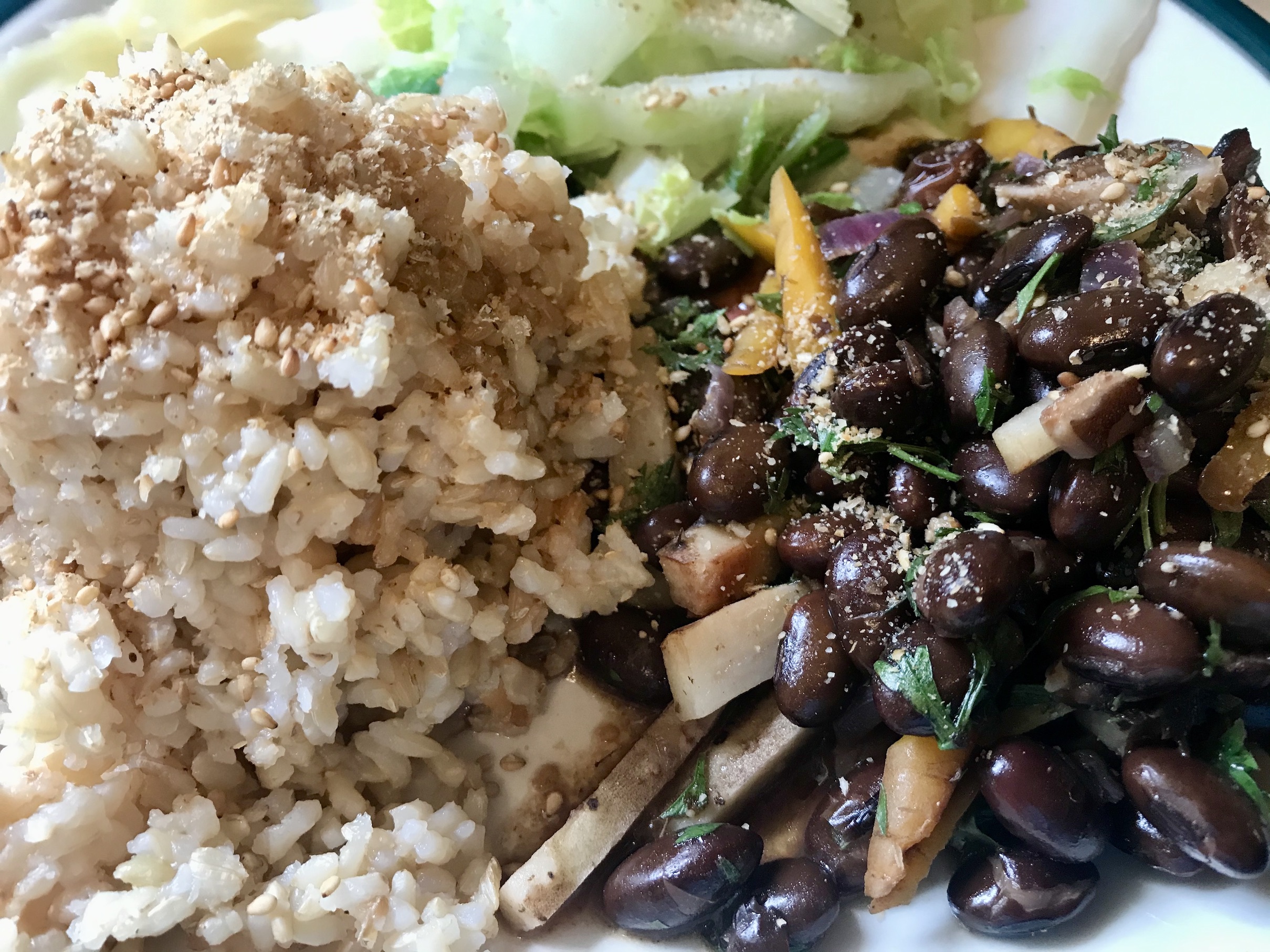 Brown Rice w/ Gomashio, Black Soy Beans cooked w/ Seaweed & Napa Cabbage w/ Umeboshi Vinegar - three top condiments used for macrobiotic cooking
Brown Rice w/ Gomashio, Black Soy Beans cooked w/ Seaweed & Napa Cabbage w/ Umeboshi Vinegar - three top condiments used for macrobiotic cooking
Healing Remedy, Sauces & Summer Drink Using Umeboshi Plums
Healing Remedy:
A common use for umeboshi plums or paste is for making special healing beverages, most notably Ume Sho Kudzu Drink, also called Morning Tea Drink which is very healing and alkalizing. The recipe for Morning Tea can also be found in The Macrobiotic Action Plan, Your MAP to Greater Health & Happiness. Or, watch me make it and explain the many health benefits in the video below.
We began to drink this nearly every morning for a couple weeks before starting our 7-10-Day 'Brown Rice Diet' which I chronicled in video format on my Vegan Great Life YouTube channel.
While not highlighted here, be sure to read more about the many healing benefits of Kudzu Root Healing Tea, along with the culinary uses for kudzu root, another ingredient commonly used in macrobiotic cooking and healing remedies.
Sauce or Summer Drink:
Older macrobiotic cookbooks, including Zen Macrobiotics mentioned above recommend simmering whole plums in a small amount of water to soften them, then macerating it with the simmering water to use as part of a sauce or dressing.
Several plums can be boiled in a larger amount of water to make a refreshing drink enjoyed chilled. The salty and sour flavor acts like an astringent to counter the loss of salts while sweating during the summer heat.
Time to talk seaweeds! I share some studies on the anti-tumor properties of seaweeds, and a few ways you can incorporate more seaweed into your meals.
Seaweeds - A Nutrient-Rich Sea Vegetable &/or Condiment for Macrobiotic Cooking
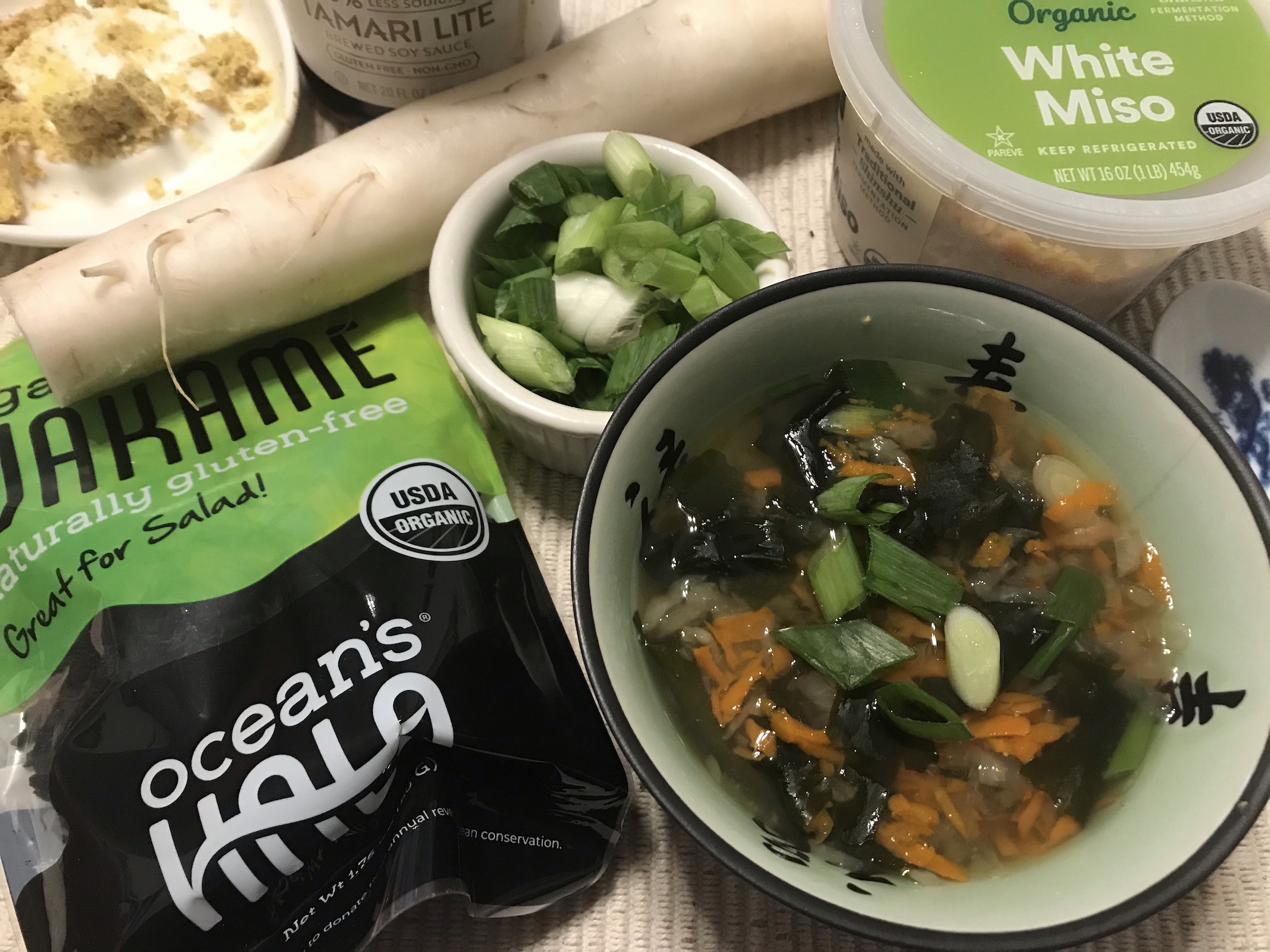 Wakame is a mineral-rich seaweed often added to Miso Soups or Cucumber Salad; White Miso is milder, sweeter & lower in sodium; add to soups, dips, dressings++ Wakame is a mineral-rich seaweed often added to Miso Soups or Cucumber Salad; White Miso is milder, sweeter & lower in sodium; add to soups, dips, dressings++ |
Seaweeds can be cooked or used as condiments for macrobiotic cooking. They provide iodine in the diet, along with many other trace minerals. They are super versatile, and come in a variety of shapes, textures and colors, each with its own ideal purpose.
I've highlighted some studies indicating several health protective benefits of seaweeds, and several types of commonly used seaweeds, with emphasis on a few that can be used as a condiment for macrobiotic cooking.
Seaweed has been found to have anti-cancer effects (1), (2), and benefits to overall health. (3).
In Chinese food therapy, seaweed has a cold nature and salty taste. It is used to 'soften hardness,' clear heat, detoxify, neutralize radioactive material, provide minerals and promote diuresis. It is used to treat goiter, cough, edema, cystic breasts, modules, lumps, cancer, and low thyroid.(4)
For the simplest way to use seaweed in macrobiotic cooking, you can purchase Maine Coast Organic Dulse Granules, or Organic Kelp Granules to shake on food, but I'd like to inspire you to use seaweeds more often as they are very hearty plants, and great sources of iodine, especially important to supplement if consuming plant-based diets.
Types of Seaweeds & Ways To Use Them
- Use kelp or kombu when preparing dried beans, lentils or split peas, such as this Vegan Split Pea Soup to help tenderize beans when cooked from dry, and improve their digestibility. We never cook dried beans or peas without adding a 3-4 inch piece of kelp or kombu seaweed to the pressure cooker, or when making Clay Pot Cooked Beans, such as these Ginger Sesame Black Beans.
- Kelp or kombu are used to prepare this Simple Japanese Dashi Broth for noodle dishes and as a base for Miso Soups.
- Wakame (from the Pacific Ocean, or Alaria (from the Atlantic Ocean) is very rich in calcium and other minerals. I add wakame or alaria to Miso Soups.
- Make Seaweed Condiment: Soak alaria or kelp seaweed in water for 10+ minutes, then simmer in a little water until soft. (Or just simmer until soft.) Add 1+ Tbsp. of shoyu or tamari, and simmer a little longer until most of the liquid has cooked out. Serve a little seaweed condiment with your meals.
- Nori is used for making Brown Rice Sushi or Brown Rice Balls.
- For a slightly smoky flavor, try Dulse, a delicate, red seaweed that can be used as is, or lightly toasted, and has a flavor somewhat similar to smoked salmon, or like bacon when crisped up first. Dulse gives my Vegan Split Pea Soup a hint of the smoky flavor people enjoy, without the ham. I also add dulse to my Southern Style Greens recipe in Basic Macrobiotic Menus & Recipes, to be republished in 2025. Dulse is a summer algae that grows on the northern coasts of the Atlantic and Pacific oceans. According to Wikipedia, the earliest record of dulse is from the island of Iona, Scotland, where Christian monks harvested dulse 1400 years ago. It is commonly used as a snack, or source of fiber in Iceland and in Ireland.
- Dulse can be lightly toasted in the oven set at about 300º for a few minutes, until it firms up and gets crisp. A higher oven can be used, but pay attention, as it burns quickly. Or toast in a skillet.
- Dulse is great stirred into porridge, such as this Oat Millet Porridge (one of our favorites) or Oat Barley Porridge, and can be added to vegetable dishes, stir fries, salads, or even on a sandwich.
- Hijiki and arame seaweeds are a great addition to stir fried vegetables, or can be soaked to soften, then tossed with vegetable and/or grain and vegetable-based salads.
I order a wakame and hijiki from Amazon and have linked the ones I like, above. The rest of the seaweed we order in bulk from Larch (Maine Seaweed) at TheSeaweedMan.com. (Very highly recommended!!!)
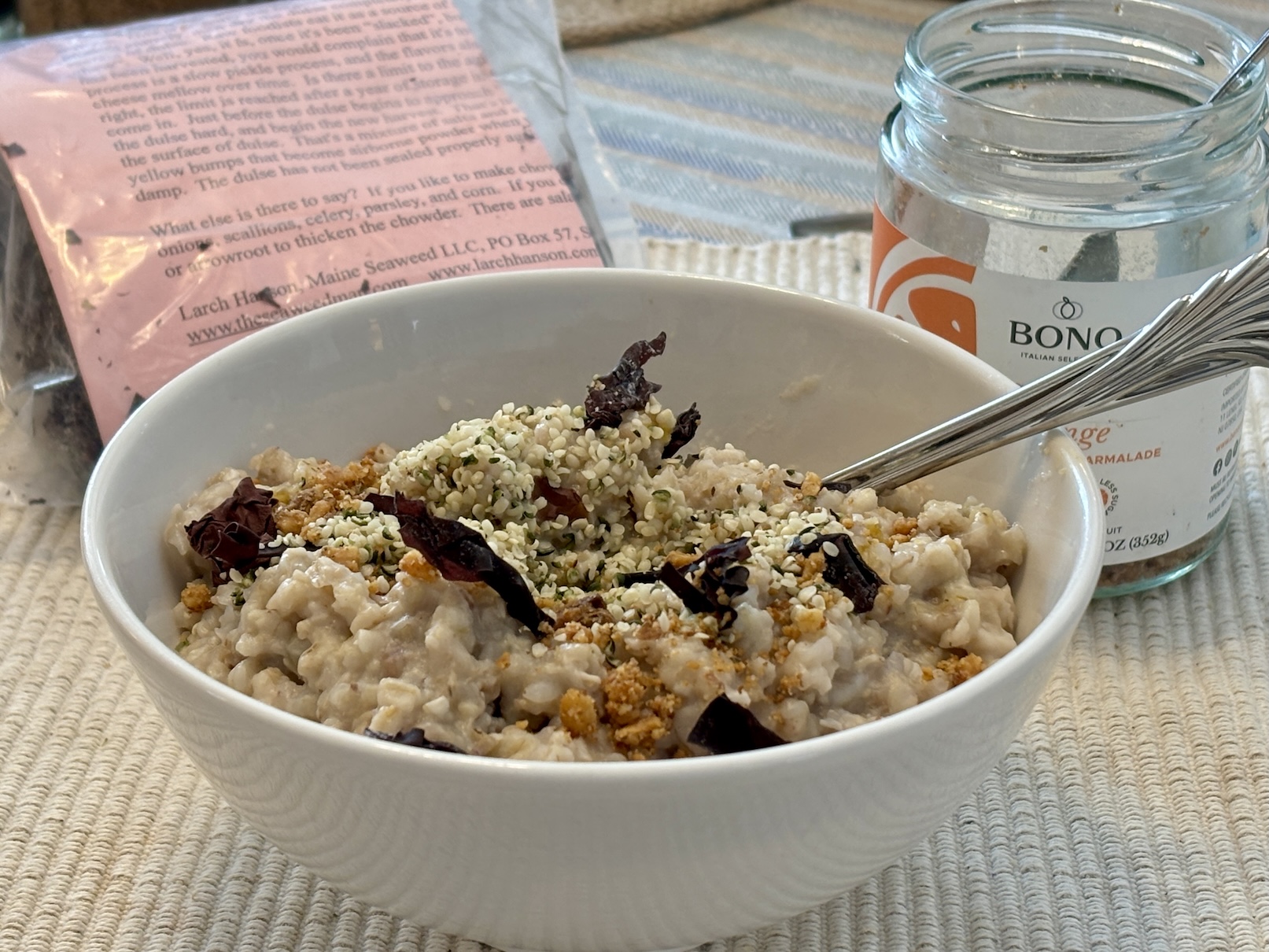 Breakfast Oat Porridge with Dulse stirred in, topped with Gomashio & Walnut-Salt
Breakfast Oat Porridge with Dulse stirred in, topped with Gomashio & Walnut-Salt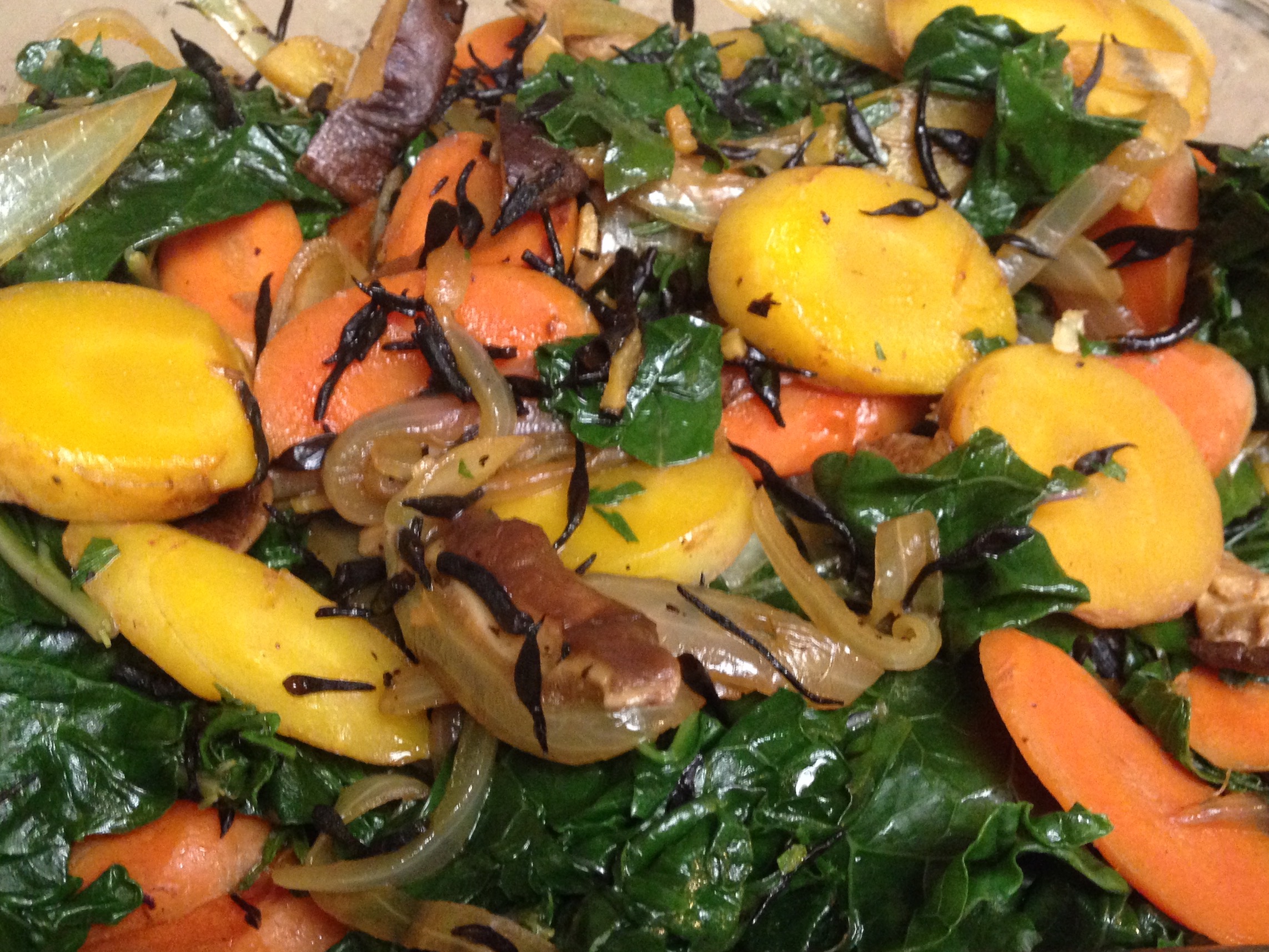 Colorful Carrot Medley & Greens w/ Hijiki
Colorful Carrot Medley & Greens w/ Hijiki
Nutritional Yeast (aka 'Nooch'): Bonus Condiment Common among Plant-Based Dieters
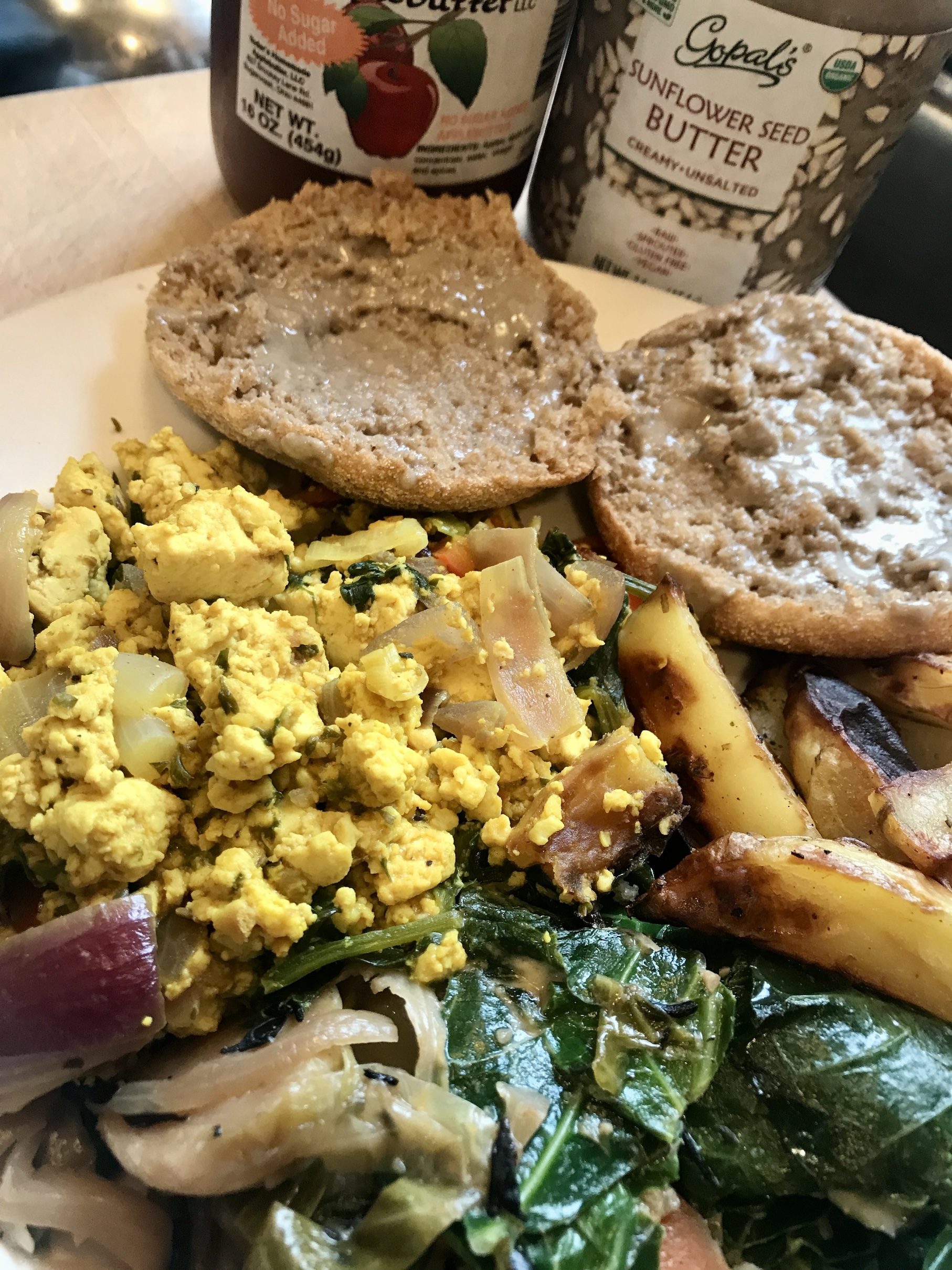 Tofu Scramble w/ Greens & Whole Wheat English Muffin (above), Baked Potato & Green Beans (Top, R); and Baked Tofu w/ Chorizo ~ all w/ Nutritional Yeast Tofu Scramble w/ Greens & Whole Wheat English Muffin (above), Baked Potato & Green Beans (Top, R); and Baked Tofu w/ Chorizo ~ all w/ Nutritional Yeast |
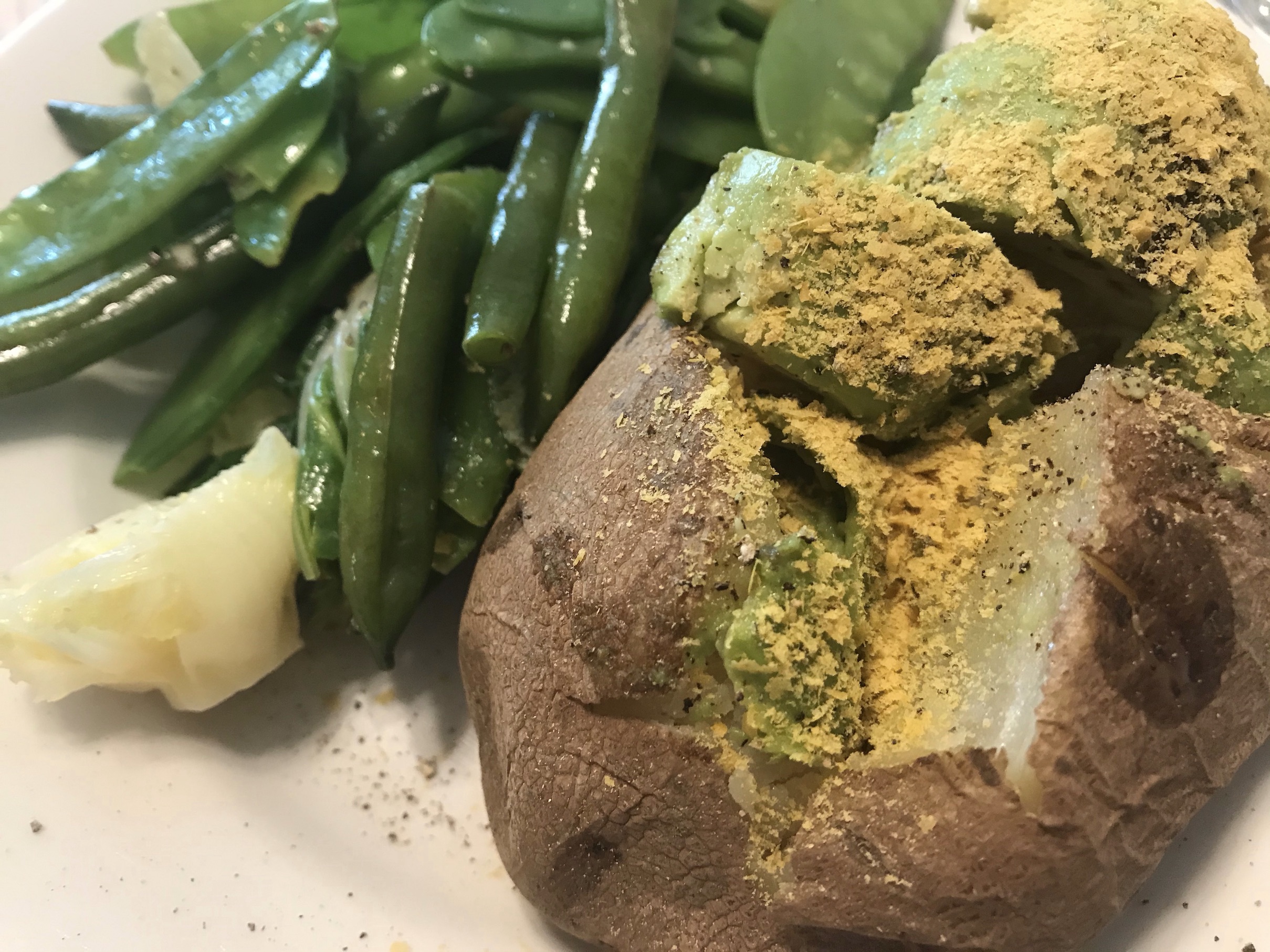 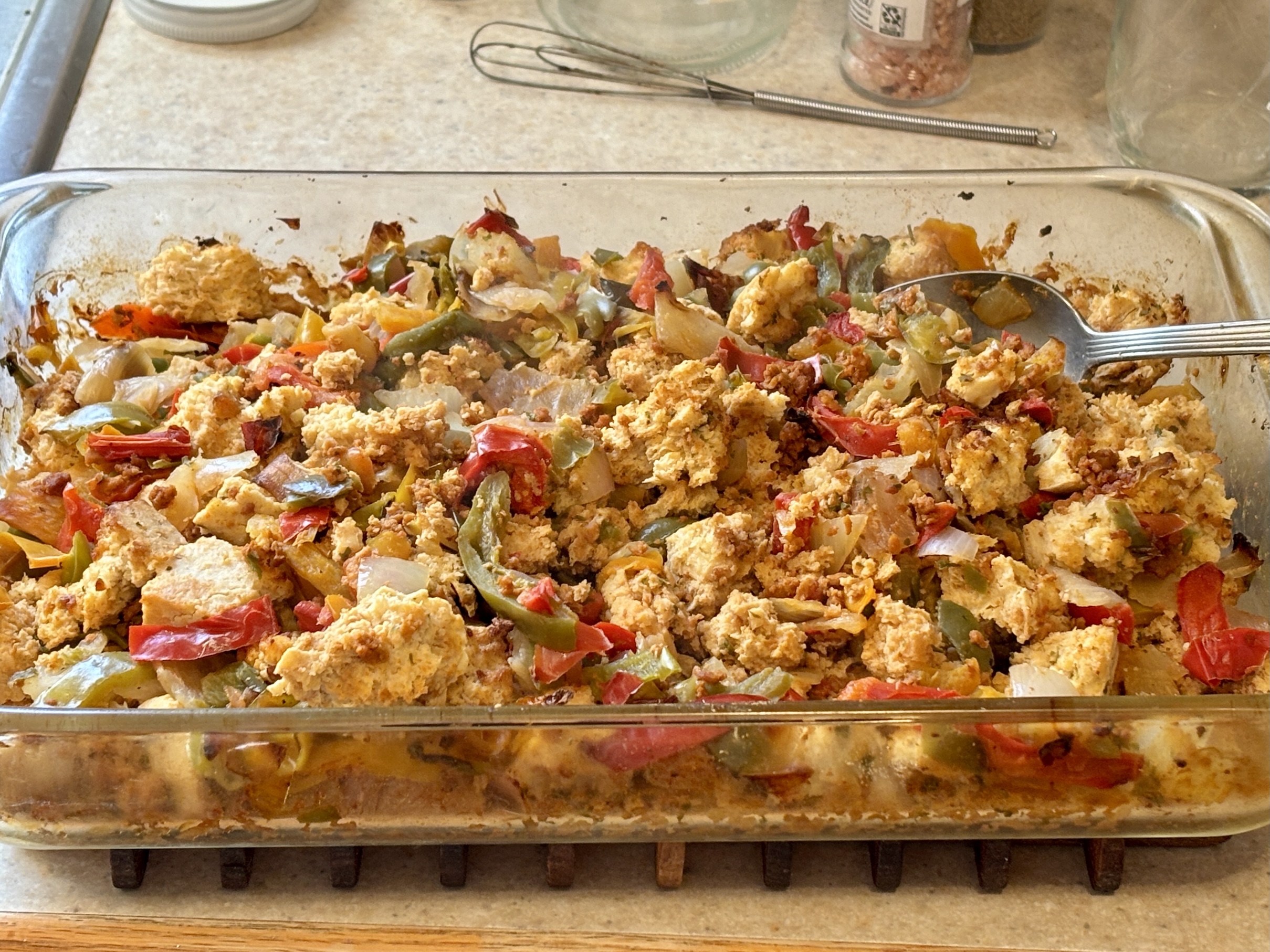 |
Nutritional Yeast is a favorite among vegan and plant-based dieters as the golden yellow flakes (or powder) impart a slightly salty, cheesy taste, are a good source of B vitamins, and can be used to make plant-based cheese sauces, like macaroni and cheese, and the best Tofu Scramble, or Baked Tofu Scramble with Chorizo (both shown above.)
I like Terrasoul Nutritional Yeast, for its flavor and naturally occurring B vitamins (versus synthetic.)
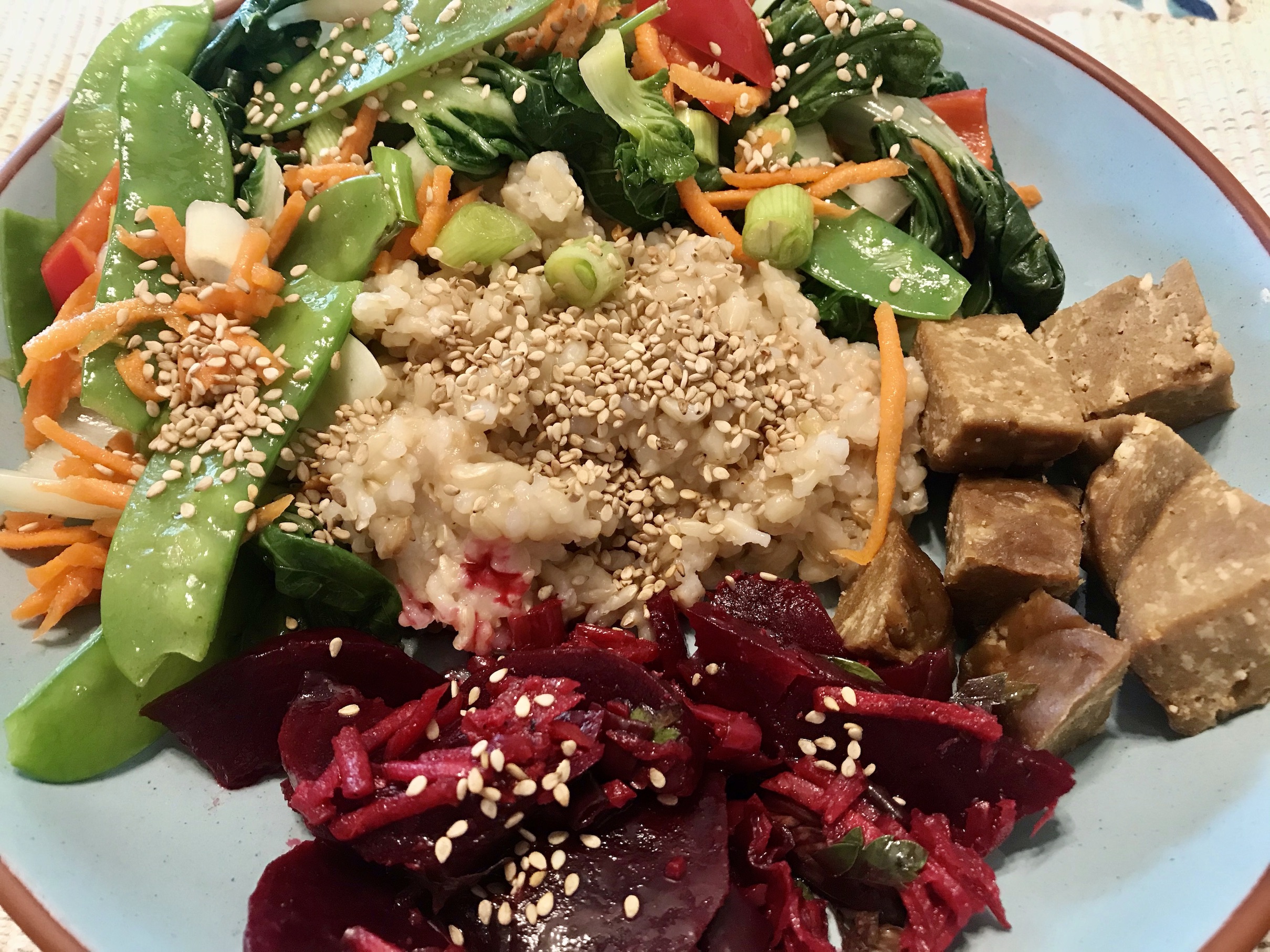 Brown Rice, Homemade Wheat Meat (Seitan) & Vegetables w/ Gomashio Garnish Brown Rice, Homemade Wheat Meat (Seitan) & Vegetables w/ Gomashio Garnish |
In Summary...
Salty condiments for macrobiotic cooking are used to improve digestion of grains and vegetables, which we discovered directly during our 7-10 Day Ohsawa 7 / Brown Rice Diet, which you can watch on my Vegan Great Life YouTube channel, or watch the final video summarizing our experiences along with my tips for others, below.
A note about all the resources: I've included links to those products I use, or trust to be of a better quality and value. Some of these may also be found at your local natural foods store, Whole Foods, or online for a better price at Vitacost.com. Any purchases made through the above links do provide a small commission for me, which helps support my time to continue making more informative content available, and is greatly appreciated!
RECIPES FEATURED USING CONDIMENTS FOR MACROBIOTIC COOKING
To learn more:
Want to get started eating a healthy balanced vegan macrobiotic diet / or a simple plant-based diet?
>>>Return to Home Page
>>>Vegan / Vegetarian / Plant-Based Diet Basics >>>Plant-Based Meal Prep >>>Top Healthy Condiments for Macrobiotic Cooking
Research Cited for Healthy Condiments for Macrobiotic Cooking Article:
(1) PubMed. Study: Anti-cancer effects of different seaweeds on human colon and breast cancer
(2) PubMed, Comparison of Tomixifen with edible seaweed extracts in suppressing breast tumor
(3) PubMed, Seaweed and human health
(4) The Tao of Nutrition, Maoshing Ni, Ph.D., C.A. with Cathy McNease, B.S., M.H.
(5) PubMed, Miso: A traditional nutritious & health endorsing fermented product review
(6) PubMed, Miso, A Traditional Nutritious and Health Endorsing Fermented Product
(8) Quote used in The Macrobiotic Action Plan taken from The Macrobiotic Way: The Complete Macrobiotic Diet & Exercise Book, by Michio Kushi
